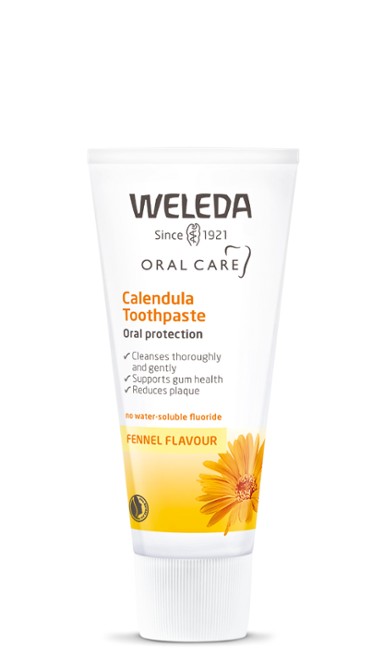
Dental care – with and without fluoride
Weleda offers you the choice
A good diet, daily oral hygiene and fluoride intake – these are the three pillars of healthy teeth. Fluoride hardens the tooth enamel and helps prevent cavities. But excessive fluoride can be harmful. If you opt for a fluoride-free toothpaste, Weleda offers alternatives.
Fluoride belongs to the so-called trace elements. In small amounts, fluoride has positive effects on our bones and teeth, but in large amounts it can also have negative effects.
Not only does it harden the bones in our body, but also our tooth enamel. Supplying the body with sufficient fluoride is therefore important to prevent tooth decay (also called cavities or dental caries).
In children, however, excessive fluoride can lead to dental fluorosis. This dental disorder is characterised by tooth discoloration that can range from white spots to brown stains on the tooth enamel. Not only is this a cosmetic concern; dental fluorosis can also reduce the enamel’s resistance to dental caries.
Fluoride needs vary from person to person
Fluoride needs vary from person to person due to differences in tooth structure. Daily intake comes not only from food and drink but also from products like toothpaste and mouthwash. Common sources of fluoride include fish, cereals, milk, dairy products, and nuts - particularly walnuts. Additionally, using fluoridated salt in cooking or consuming fluoridated drinking water may already fulfill an individual’s fluoride requirements.
The table below outlines the recommended adequate daily intake in New Zealand and the established upper intake levels for different population groups:
|
Population subgroup |
Adequate intake (mg/day) |
Upper level (mg/day |
|
Infants 0–6 months |
0.01 |
0.7 |
|
Infants 7–12 months |
0.5 |
0.9 |
|
1–3 years |
0.7 |
1.3 |
|
4–8 years |
1.0 |
2.2 |
|
9–13 years |
2.0 |
10.0 |
|
14–18 years |
3.0 |
10.0 |
|
19+ years - Male |
4.0 |
10.0 |
|
19+ years - Female |
3.0 |
10.0 |
Source: Ministry of Health 2009 Guidelines for the Use of Fluorides.
Sources of fluoride
Foods that are typically high in fluoride include:
- Tea: Especially black and green tea.
- Seafood (especially with bones): Canned fish with bones (e.g., sardines, salmon), shellfish (e.g., shrimp, crab) and seaweed.
- Water: In New Zealand, fluoride naturally occurs in drinking water but typically at low levels - on average around 0.2 mg/L. When the water supply is fluoridated, the goal is to increase it to between 0.7 and 1.0 mg per litre.
- Fruits and Vegetables: Spinach, Lettuce, Potatoes, Grapes (and Wine).
- Processed foods: Foods and beverages made with fluoridated water (e.g., soups, soft drinks, reconstituted juices).
These are some common sources, but the amount of fluoride can vary widely depending on where the food is grown or sourced from.
Regulation of fluoride in toothpaste
In New Zealand, the fluoride content in toothpaste is regulated by law. Adult toothpastes may contain a maximum of 0.15% fluoride (1500 ppm - parts per million). These levels are also recommended by dentists for children aged 6 years and older. Toothpastes marketed as “junior” (for children over 6) generally only differ from adult versions in taste.
For younger children (under 6 years), fluoride exposure must be limited to reduce the risk of dental fluorosis, a condition affecting teeth that have not broken through. Dental fluorosis can occur when fluoride intake reaches 0.1 mg per kilogram of body weight per day. Therefore, toothpastes intended for younger children typically contain a lower fluoride concentration, with a recommended maximum of 0.05%.
Fluoride therapy for medical purposes
As noted above, fluoride can easily be overdosed, and particular care should be taken if fluoride supplements (e.g. tablets or drops, etc.) have been prescribed by a paediatrician or dentist. The administration of fluoride is indicated in individual cases of deficiency symptoms. A doctor should determine the dosage and duration of the treatment individually, taking into account the fluoride intake from other sources.
Difference between fluorine and fluoride
Fluorine is – like chlorine – a highly reactive chemical element and exists as a gas. It combines very quickly with other elements and therefore does not occur freely in nature, but mostly as salt compounds, called fluorides.
Fluorides are named according to the other element substance the fluorine has combined with, e.g. sodium fluoride or potassium fluoride (in the case of chlorine, this would correspond to sodium chloride = common salt).
Go fluoride-free with Weleda
Discover Weleda’s natural oral care range - crafted without water-soluble fluorides. It’s the trusted fluoride-free alternative for those who want a gentle, effective and holistic approach to oral health.
Need some help finding the right toothpaste for you?
















